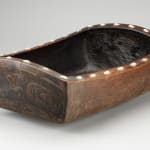-
Artworks
UNIDENTIFIED TLINGIT OR TSIMSHIAN ARTIST
Feast Bowl, c. 1820-50carved and stained wood, with inlaid opercula, 5.5 x 17.5 x 12.25 in (14 x 44.5 x 31.1 cm)
unsigned.
LOT 17
ESTIMATE: $20,000 — $30,000
PRICE REALIZED: $19,040.00Further images
Carved wooden food vessels are some of the most graceful objects made on the Northwest Coast, and this example is certainly one of those. The rectangular shape of this bowl...Carved wooden food vessels are some of the most graceful objects made on the Northwest Coast, and this example is certainly one of those. The rectangular shape of this bowl is a traditional form; bowls were carved in sizes from small one-handers to two feet and more in length. An intriguing geometric design of parallel grooves appears at each corner of this bowl, which the late Bill Holm has said may be a skeuomorphic reference to the folded corners of Athabaskan birchbark vessels of related shape. Like most Northwest Coast vessels, the arched ends and swooping sides create a dynamic appearance in a wooden vessel. Red turban snail opercula inlaid in the wide, undercut rim appear in the finest examples, like this one. The design relief carved at each end is a formline face structure, but are too general in form to be identifiable. The formlines themselves are relatively heavy in width and angular compared to some other examples. This suggests a period of origin in the second quarter of the nineteenth century.
Steven. C. Brown
References: For other northern Northwest Coast examples of this type see Bill Holm, The Box of Daylight: Northwest Coast Indian Art, (Seattle: Seattle Art Museum and Univ. of Washington Press, 1983), cats. 117-119. For a similar Haida example c. 1850 see Gilbert T. Vincent et al, Art of the North American Indians: The Thaw Collection, (Cooperstown: Fenimore Art Museum, 2000) p. 340. See also Renwick Gallery of the Smithsonian American Art Museum, Boxes and Bowls; Decorated Containers by Nineteenth-Century Haida, Tlingit, Bella Bella, and Tsimshian Indian Artists, (Washington: Smithsonian Institution Press, 1974), cats. 34-40. For a small, early example see Thomas Vaughan and Bill Holm, Soft Gold: The Fur Trade & Cultural Exchange on the Northwest Coast of America, (Portland, OR: Oregon Historical Society Press, 1990), no. 18.
Provenance
A British Columbia Collection.
Join our mailing list
* denotes required fields
We will process the personal data you have supplied in accordance with our privacy policy (available on request). You can unsubscribe or change your preferences at any time by clicking the link in our emails.








